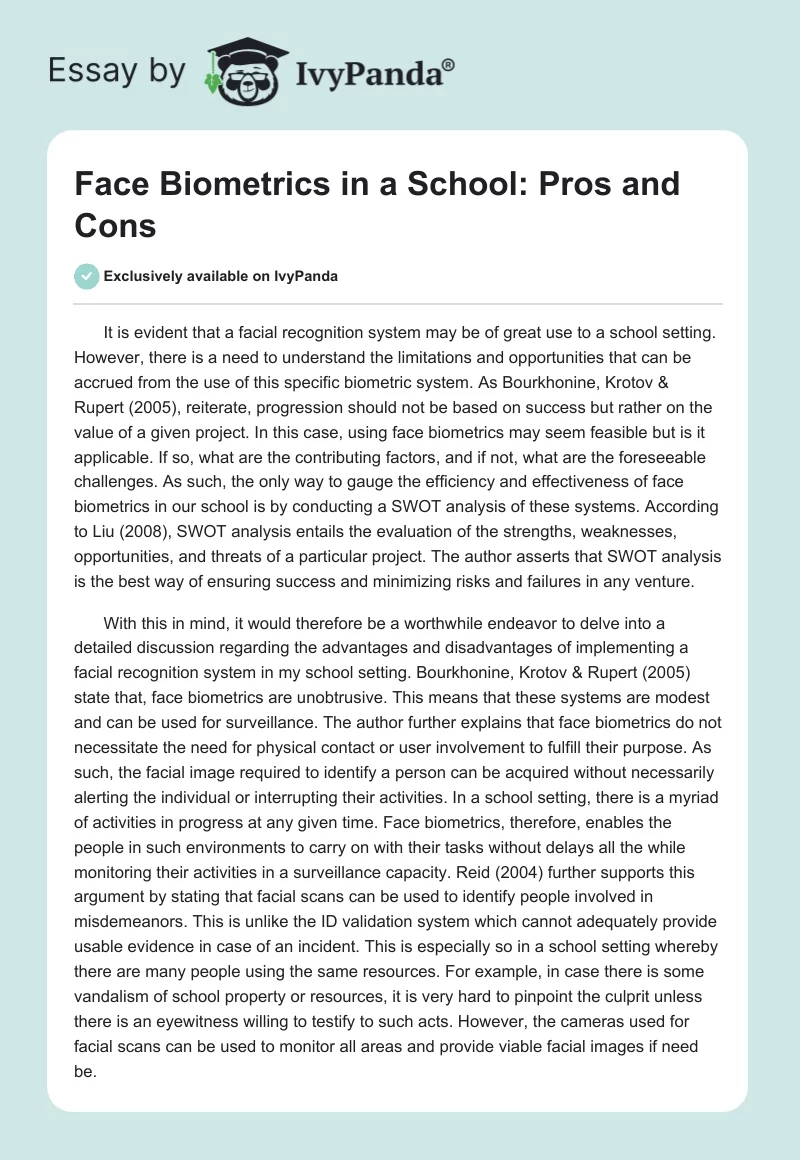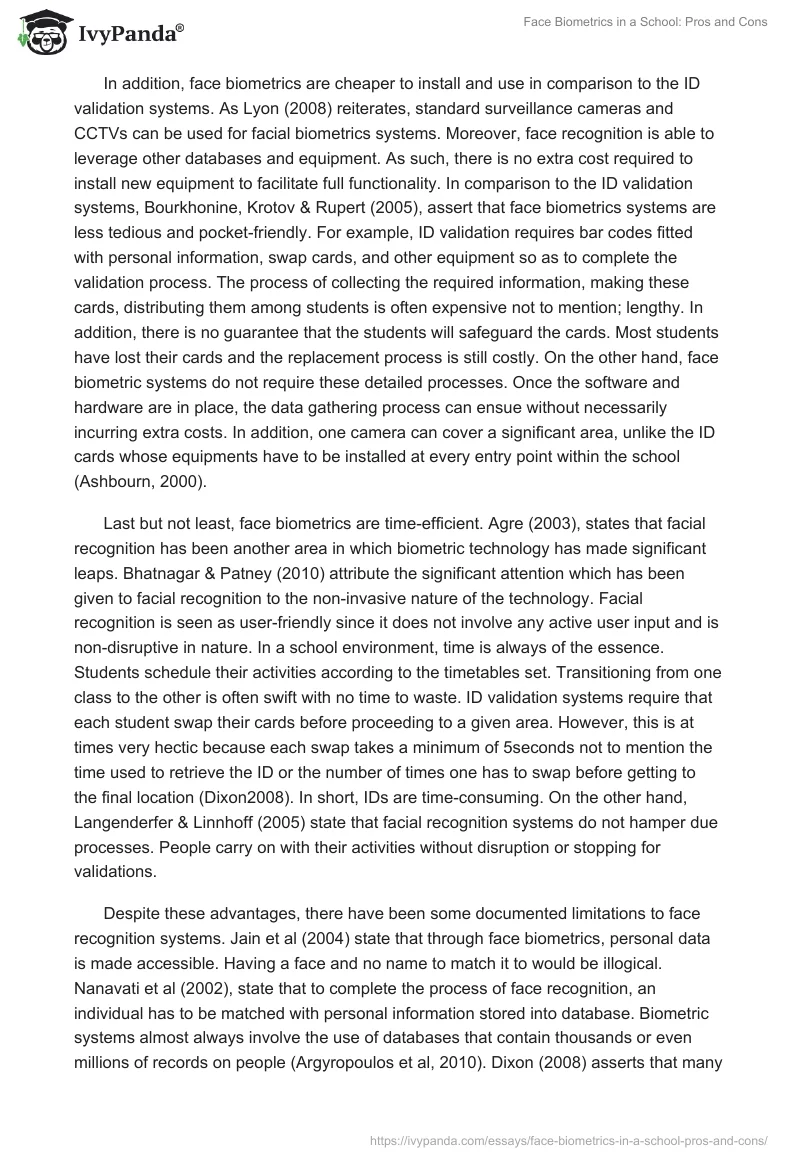It is evident that a facial recognition system may be of great use to a school setting. However, there is a need to understand the limitations and opportunities that can be accrued from the use of this specific biometric system. As Bourkhonine, Krotov & Rupert (2005), reiterate, progression should not be based on success but rather on the value of a given project. In this case, using face biometrics may seem feasible but is it applicable. If so, what are the contributing factors, and if not, what are the foreseeable challenges. As such, the only way to gauge the efficiency and effectiveness of face biometrics in our school is by conducting a SWOT analysis of these systems. According to Liu (2008), SWOT analysis entails the evaluation of the strengths, weaknesses, opportunities, and threats of a particular project. The author asserts that SWOT analysis is the best way of ensuring success and minimizing risks and failures in any venture.
With this in mind, it would therefore be a worthwhile endeavor to delve into a detailed discussion regarding the advantages and disadvantages of implementing a facial recognition system in my school setting. Bourkhonine, Krotov & Rupert (2005) state that, face biometrics are unobtrusive. This means that these systems are modest and can be used for surveillance. The author further explains that face biometrics do not necessitate the need for physical contact or user involvement to fulfill their purpose. As such, the facial image required to identify a person can be acquired without necessarily alerting the individual or interrupting their activities. In a school setting, there is a myriad of activities in progress at any given time. Face biometrics, therefore, enables the people in such environments to carry on with their tasks without delays all the while monitoring their activities in a surveillance capacity. Reid (2004) further supports this argument by stating that facial scans can be used to identify people involved in misdemeanors. This is unlike the ID validation system which cannot adequately provide usable evidence in case of an incident. This is especially so in a school setting whereby there are many people using the same resources. For example, in case there is some vandalism of school property or resources, it is very hard to pinpoint the culprit unless there is an eyewitness willing to testify to such acts. However, the cameras used for facial scans can be used to monitor all areas and provide viable facial images if need be.
In addition, face biometrics are cheaper to install and use in comparison to the ID validation systems. As Lyon (2008) reiterates, standard surveillance cameras and CCTVs can be used for facial biometrics systems. Moreover, face recognition is able to leverage other databases and equipment. As such, there is no extra cost required to install new equipment to facilitate full functionality. In comparison to the ID validation systems, Bourkhonine, Krotov & Rupert (2005), assert that face biometrics systems are less tedious and pocket-friendly. For example, ID validation requires bar codes fitted with personal information, swap cards, and other equipment so as to complete the validation process. The process of collecting the required information, making these cards, distributing them among students is often expensive not to mention; lengthy. In addition, there is no guarantee that the students will safeguard the cards. Most students have lost their cards and the replacement process is still costly. On the other hand, face biometric systems do not require these detailed processes. Once the software and hardware are in place, the data gathering process can ensue without necessarily incurring extra costs. In addition, one camera can cover a significant area, unlike the ID cards whose equipments have to be installed at every entry point within the school (Ashbourn, 2000).
Last but not least, face biometrics are time-efficient. Agre (2003), states that facial recognition has been another area in which biometric technology has made significant leaps. Bhatnagar & Patney (2010) attribute the significant attention which has been given to facial recognition to the non-invasive nature of the technology. Facial recognition is seen as user-friendly since it does not involve any active user input and is non-disruptive in nature. In a school environment, time is always of the essence. Students schedule their activities according to the timetables set. Transitioning from one class to the other is often swift with no time to waste. ID validation systems require that each student swap their cards before proceeding to a given area. However, this is at times very hectic because each swap takes a minimum of 5seconds not to mention the time used to retrieve the ID or the number of times one has to swap before getting to the final location (Dixon2008). In short, IDs are time-consuming. On the other hand, Langenderfer & Linnhoff (2005) state that facial recognition systems do not hamper due processes. People carry on with their activities without disruption or stopping for validations.
Despite these advantages, there have been some documented limitations to face recognition systems. Jain et al (2004) state that through face biometrics, personal data is made accessible. Having a face and no name to match it to would be illogical. Nanavati et al (2002), state that to complete the process of face recognition, an individual has to be matched with personal information stored into database. Biometric systems almost always involve the use of databases that contain thousands or even millions of records on people (Argyropoulos et al, 2010). Dixon (2008) asserts that many students, as well as citizens, also fear the centralization of crucial information about them. They claim that it is bound to be misused. On many occasions data has been collected for particular reasons but later used for different purposes other than the intended ones. This has made many refrain from offering personal information claiming that it may lead to intrusion of their privacy.
Other than this, the likelihood of failure in these systems is imminent. Mordini & Massari (2008) assert that face recognition uses salient features of an individual’s face to identify him/her. However, even the slightest alteration may lead to false results. The author states that elements such as facial hair, sunglasses, change in hairstyle and environmental factors (darkness or too much light) may impact the accuracy of the system. Bhatnagar, Lall & Patney (2010) further claims that the positioning of the cameras may also affect the quality of the results given. If wrongly placed, the cameras would not be able to collect all of the required features thereby leading to inaccurate results. This is unlike the ID validation systems whereby the results generated are accurate and precise (Reid, 2004). As such, facial biometrics are not as accurate as would be expected in a school setting where security is key to ensuring harmonious coexistence among the members of such communities.
Finally, Liu (2008), states that operator abuse and sabotage are likely in these systems. With the increase in the application of biometric technology for security solutions, there has been an outburst of concerns over the privacy implications that this technology presents to the common man. There is concern as to the information falling into the wrong hands or being used for purposes other than that it was intended to by the holders of the information. Sonkamble et al (2010) further claim that cameras can easily be blinded or redirected by individuals willing to remain undetected. In addition, there have been cases whereby the operators of these surveillance systems have been spotted spying on people. For example, operators use the cameras to stalk students and invade their privacy, others use compromising clips to blackmail the students and demand monetary or sexual favors for their silence. ID validation systems cannot be subjected to such atrocities and are therefore better placed in terms of safety and sabotage resistance.
References
Agre, P. (2003). Your Face Is Not a Bar Code: Arguments Against Automatic Face Recognition in Public Places. Web.
Argyropoulos, S., Tzovaras, D., Ioannidis, D., Damousis, Y., Strintzis, M. G., Braun, M., & Boverie, S. (2010). Biometric template protection in multimodal authentication systems based on error correcting codes. Journal of Computer Security, 18(1), 161-185. Web.
Ashbourn, J. (2000). Biometrics: Advanced Identity Verification. London, UK: Springer-Verlag.
Bhatnagar, J. R., Lall, B., & Patney, R. K. (2010). Performance issues in biometric authentication based on information theoretic concepts: A review. IETE Technical Review, 27(4), 273-285. Web.
Bourkhonine, S., Krotov, V., & Rupert, B. (2005). Future Security Approaches and Biometrics. Communications of the Association for Information Systems, 16(1), 937-966.
Dixon, P. (2008). Ethical issues implicit in library authentication and access management: Risks and best practices. Journal of Library Administration, 47(3), 141-162.
Jain, A., Hong, L., & Pankanti, S. (2000). Biometric Identification. Communications of the ACM, (43) 2, 91-98.
Langenderfer, J., & Linnhoff, S. (2005). The emergence of biometrics and its effect on consumers. Journal of Consumer Affairs, 39(2), 314-338.
Liberatore, A. (2007). Balancing security and democracy, and the role of expertise: Biometrics politics in the european union. European Journal on Criminal Policy & Research, 13(1), 109-137. Web.
Liu, Y. (2008). Identifying legal concerns in the biometric context. Journal of International Commercial Law & Technology, 3(1), 45-54.
Lyon, D. (2008). Biometrics, identification and surveillance. Bioethics, 22(9), 499-508.
Mordini, E., & Massari, S. (2008). Body, biometrics and identity. Bioethics, 22(9), 488-498.
Nanavati, S., Thieme, M., & Nanavati, R. (2002). Biometrics: Identity Verification in a Networked World. New York, NY: John Wiley & Sons, Inc.
Reid, P. (2004). Biometrics For Network Security. Upper Saddle River, N.J.: Prentice Hall PTR.
Sonkamble, S., Thool, D. R., & Sonkamble, B. (2010). Survey of biometric recognition systems and their applications. Journal of Theoretical & Applied Information Technology, 11(1), 45-51.


